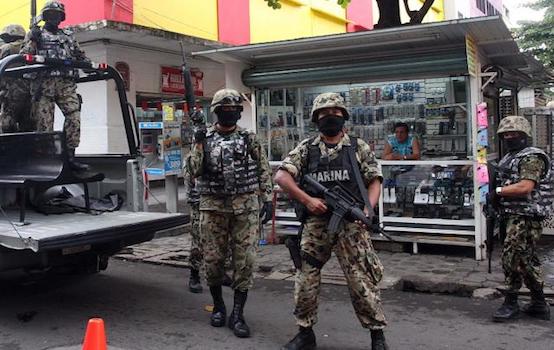Mexican Drug Violence Only Getting Worse

Both Mexican and U.S. officials basked in satisfaction when Mexican marines captured Joaquin “El Chapo” Guzman Loera, leader of the notorious Sinaloa drug cartel, in January 2016. True, Guzman had previously escaped from maximum-security prisons in Mexico on not one, but two, occasions. But this time, authorities were determined there would be no repetition, imposing unprecedented security procedures to confine the elusive inmate. Furthermore, the U.S. government moved immediately to have Guzman extradited. That petition was successful, and Mexico sent him in chains to the United States in January 2017. Guzman was extremely unlikely to be able to duplicate his strategy of bribing prison guards to escape from a U.S. maximum security facility.
Authorities on both sides of the Rio Grande heralded El Chapo’s removal as a major victory in the war on illegal drugs. The triumphalism among U.S. leaders was especially pronounced. Attorney General Loretta Lynch stated that his apprehension was “a blow to the international drug-trafficking syndicate” Guzman led, and it was “a victory for the citizens of both Mexico and the United States.” A senior U.S. Drug Enforcement Administration official insisted that Guzman was “the number one drug-trafficking figure in history and he’s been probably the world’s biggest criminal fugitive. And so it’s a huge win.”
Matters have not turned out at all the way drug warriors and other optimists assumed. Instead, El Chapo’s capture has made the violent chaos in Mexico worse—much worse. His fall created a power vacuum throughout Mexico’s ruthless drug trade. The extent of the upsurge in violence as his would-be successors maneuver for control is horrifying. In May alone, there were 2,186 fatalities—the third time in 2017 when the monthly death toll topped 2,000. That is more than twice the average monthly pace of the bloody years of Felipe Calderon’s presidency (2006-2012), when more than 60,000 Mexicans perished in drug-related carnage. The May total was a new record, and it brought the total number of deaths in 2017 to 9,906. That was an increase of 33 percent over 2016, which had already seen a worrisome rise.
The current situation is at its worst overall in the western states of Guerrero, Jalisco, and Sinaloa, where the power struggles are the most intense. But the greatest surge in violence is occurring in Baja California, home to several of Mexico’s most prominent resorts, as the rival gangs fight to gain control of the lucrative trafficking routes into the San Diego area. The situation is also bad in northern portions of the country, especially the states of Chihuahua and Tamaulipas, along the border with the United States.
Under Guzman’s leadership, the Sinaloa cartel had become, by far, Mexico’s most powerful drug trafficking operation, controlling nearly 50 percent of the commerce. Although considerable violence accompanied that consolidation of market share, as the Sinaloa organization’s grip on the trade grew tighter, the turmoil ebbed modestly after 2012.
That encouraging trend has now sharply reversed. A 2017 report from the University of San Diego’s Justice in Mexico Program notes that the killings began to edge upward in 2015 when Guzman was briefly back in custody following more than a decade of freedom after his original escape in January 2001, dipped slightly when he escaped again, and “then rose noticeably with his recapture and extradition.”
That development was not surprising, since his removal triggered leadership rivalries within the hugely profitable Sinaloa organization. There is now a ferocious three-way struggle for control. In addition to Sinaloa’s bloody internal strife, longtime competitors such as the Gulf cartel, the Juarez cartel, and Los Zetas, which Guzman had outmaneuvered and weakened, have reasserted themselves. They also have become more aggressive in responding to government anti-trafficking operations.
New entrants into the drug trade, especially Cartel Jalisco Nueva Generacion, are triggering additional violence. Indeed, the CJNG seems even more ruthless than Sinaloa, Los Zetas, and other older trafficking groups. That unprecedented, sometimes almost maniacal, viciousness is true in CJNG’s treatment of both trafficking rivals and the authorities.
Mexico’s growing agony confirms once again the folly of drug prohibition. That strategy ensures that the most odious criminal elements will dominate the trade. Given the robust consumer demand for drugs in the United States and elsewhere, prohibition merely drives up the retail price and creates an enormous potential profit for those willing to accept the risks entailed in violating the law. The UN estimates that the burgeoning global opium trade alone now exceeds $4 billion a year. The global figure for all drugs is a whopping $500 billion, and Mexico is an especially crucial player in that illicit trade.
When there is a profitable market for a product, government policy can determine whether legitimate businesses will fill that demand or criminal gangs will do so. Punitive measures will not succeed in eliminating consumer demand or overcome other economic realities. Capturing or killing one drug lord, even an extraordinarily powerful one like El Chapo, will not ameliorate the problem in any significant or lasting sense. All such “victories” do is unleash bloody struggles for succession.
The current policy that Washington has pushed and Mexico City has accepted is creating havoc for our southern neighbor. Cartel leaders and their bank accounts may benefit from that policy, but no one else on either side of the Rio Grande is doing so. U.S. and Mexican authorities need to abandon the disastrous prohibition policy, move toward a legalized system for the commerce in psychoactive drugs, and thereby undercut the power of the cartels. Otherwise, Mexico’s agony will become even worse, and the chaos will spill over the border into the United States.
Ted Galen Carpenter, a senior fellow in defense and foreign policy studies at the Cato Institute, is the author of 10 books, including Bad Neighbor Policy: Washington’s Futile War on Drugs in Latin America and The Fire Next Door: Mexico’s Drug Violence and the Danger to America.
Comments